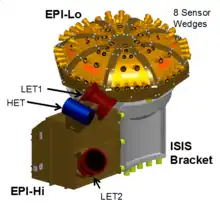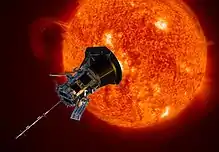.jpg.webp)
Integrated Science Investigation of the Sun or IS☉IS, is an instrument aboard the Parker Solar Probe, a space probe designed to study the Sun. IS☉IS is focused on measuring energetic particles from the Sun, including electrons, protons, and ions.[1] The parent spacecraft was launched in early August 2018, and with multiple flybys of Venus will study the heliosphere of the Sun from less than 4 million kilometers or less than 9 solar radii.[2][3]
IS☉IS consists of two detectors, EPI-Lo and EPI-Hi, corresponding to detection of relatively lower and higher energy particles.[4] EPI-Lo is designed to detect from about 20 keV per nucleon up to 15 MeV (mega electronvolts) total energy, and for electrons from about 25 keV up to 1000 keV.[4] EPI-Hi is designed to measure charged particles from about 1– to 200 MeV per nucleon and electrons from about 0.5 to 6 MeV, according to a paper about the device.[4]
The shortname includes a symbol for the Sun, a circle with a dot in it: ☉.[1] NASA suggests pronouncing the name as "ee-sis" in English.[5]
Operations

By September 2018, IS☉IS had been turned on and first light data was returned.[6]
EPI-Hi
EPI-Hi includes:[7]
- High Energy Telescope (1)
- HET has 16 detectors stacked
- Low Energy Telescopes (2)
- LET1 is double ended with 9 stacked detectors
- LET2 is single ended with 7 stacked detectors
The detectors are solid-state devices.[7]
EPI-Lo
EPI-Lo includes 8 wedge detectors, fed by 80 separate entrances.[7] These entrances correspond to covering a field of view over almost a full hemisphere.[8]
EPI-Lo can record differential energy spectra for electrons, Hydrogen, Helium-3, Helium-4, Carbon, Oxygen, Neon, Magnesium, Silicon, and Iron.[7]
See also
- JEDI (instrument on Juno Jupiter orbiter that detects energetic particles at Jupiter)
References
- 1 2 JHUAPL. "Parker Solar Probe Instruments: IS☉IS". Parker Solar Probe. Retrieved 2018-10-20.
- ↑ "NASA Solar Probe Flies By Venus on Its Way to 'Touch' the Sun". Space.com. Retrieved 2018-10-20.
- ↑ JHUAPL. "After Near-Perfect Trajectory Maneuver, Parker Solar Probe On Course To Touch The Sun". Parker Solar Probe. Retrieved 2018-10-20.
- 1 2 3 McComas, D. J.; Alexander, N.; Angold, N.; Bale, S.; Beebe, C.; Birdwell, B.; Boyle, M.; Burgum, J. M.; Burnham, J. A. (2014-07-05). "Integrated Science Investigation of the Sun (ISIS): Design of the Energetic Particle Investigation". Space Science Reviews. 204 (1–4): 187–256. doi:10.1007/s11214-014-0059-1. ISSN 0038-6308.
- ↑ "Parker Solar Probe Instruments". 12 July 2018.
- ↑ "Illuminating First Light Data from Parker Solar Probe – Parker Solar Probe". blogs.nasa.gov. 19 September 2018. Retrieved 2018-12-23.
- 1 2 3 4 McComas, D. J.; Christian, E. R.; Wiedenbeck, M. E.; McNutt, R. L.; Cummings, A. C.; Desai, M. I.; Giacalone, J.; Hill, M. E.; Mewaldt, R. E.; Krimigis, S. M.; Livi, S. A.; Mitchell, D. G.; Matthaeus, W. H.; Roelof, E. C.; Schwadron, N. A.; Stone, E. C.; von Rosenvinge, T. T. (January 2011). The Integrated Science Investigation of the Sun (ISIS): Energetic Particle Measurements for the Solar Probe Plus Mission (PDF). 32nd International Cosmic Ray Conference. Beijing, China. Archived (PDF) from the original on 28 September 2022.
- ↑ "Integrated Science Investigation of the Sun (ISʘIS) | Space Physics at Princeton".
